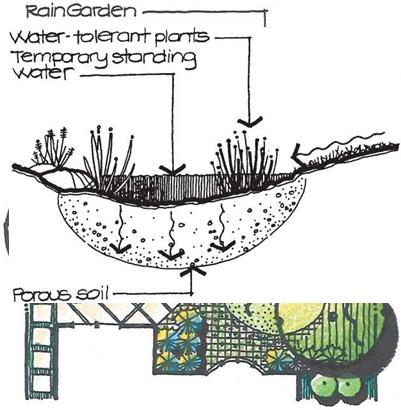The possibility of wildfires is a real threat in western arid and semiarid regions of the country. Each year, thousands of acres of land are burned and millions of dollars in property damage result from wildfires. Sustainable residential sites located in these regions should be designed to minimize the potential threat of fire damage. The first step in reducing fire hazard is to determine likely paths for the movement of wildfire toward the site. Wildfires have a tendency to move with the prevailing summer wind and uphill from a valley or canyon bottom to the tops of slopes and ridges. The heat generated by a fire rises along slopes and accelerates the movement of fire toward higher ground, thus making houses located on or at the top of steep slopes the most vulnerable (Figure 3—48).[16] Houses located on high points but set back from the slope are less exposed because they are not in the direct path of rising heat. Another factor that should be studied is the type and density of vegetation that surrounds a site. Fire is more of a danger from directions that have dense vegetation between the
 |
 |
ground and the treetops. Thickly massed living vegetation along with the remains of dead vegetation that has accumulated over years of time provides a rich fuel source for a fire and a continuous path of movement. Off-site areas that have this type of vegetation pose a threat to a residential site and should factor in when designing the site for wildfire protection.
With an understanding of the potential directions from which wildfire might approach, the residential site should be designed to create a “defensible space” that minimizes the ability of fire to spread from the perimeter of the site toward the house. The size and makeup of the defensible space should be based on topography, wind direction,
 |
 |
and off-site vegetation. The general rule of thumb is that the defensible space should extend 150 feet in all directions from the house on a site that is relatively flat or sloped up to a 20 percent gradient (Figure 3-49).[17] As the steepness of slope increases, so should the size of the defensible space, especially in the downhill direction from the house. Three subzones are recommended within the defensible space (Figure 3-50).[18] Zone 1 should extend 5 to 10 feet from the exterior wall of the house and should be treated as a break between the house and the surrounding landscape. Consequently, zone 1 may contain low plants, ground cover, and/or pavement but no tall shrubs or trees. Zone 1 should be the wettest area of the site and thus irrigated if necessary (also see “Conserve Water”). Zone 2 should extend 30 feet beyond the outside of zone 1 and can contain ground cover, low shrubs, lawn, pavement, and widely spaced trees (Figure 3—51). Plants with a high moisture content are preferred and may be native, introduced, or a combination of both. Zone 3 of the defensible space is located between zone 2 and the property line of the site. This zone may contain only native plants as long as they are thinned to prevent fire from moving between tree canopies or from the ground upward via a continuous vegetation mass. Similarly, all dead and diseased plants should be removed from zone 3 as well. Local fire regulations should be consulted to determine specific guidelines that might vary from these broad suggestions.
An associated strategy for minimizing fire hazard is to store water on a residential site as source for fighting a fire or for watering plants. Keeping plant materials watered and healthy minimizes their ability to catch fire. Dry plants, of course, readily act as tinder for a fire and promote its spread through the landscape. Again, the
|
|
 |

|
|
|

need for irrigation is greatest near the house and less so as distance from the house increases. Water can be stored in an above-ground tank or a cistern below the ground (also see “Conserve Water” in this chapter). A swimming pool is another source of water for firefighting and thus a good reason to have one in the landscape beyond the obvious recreational benefits.





